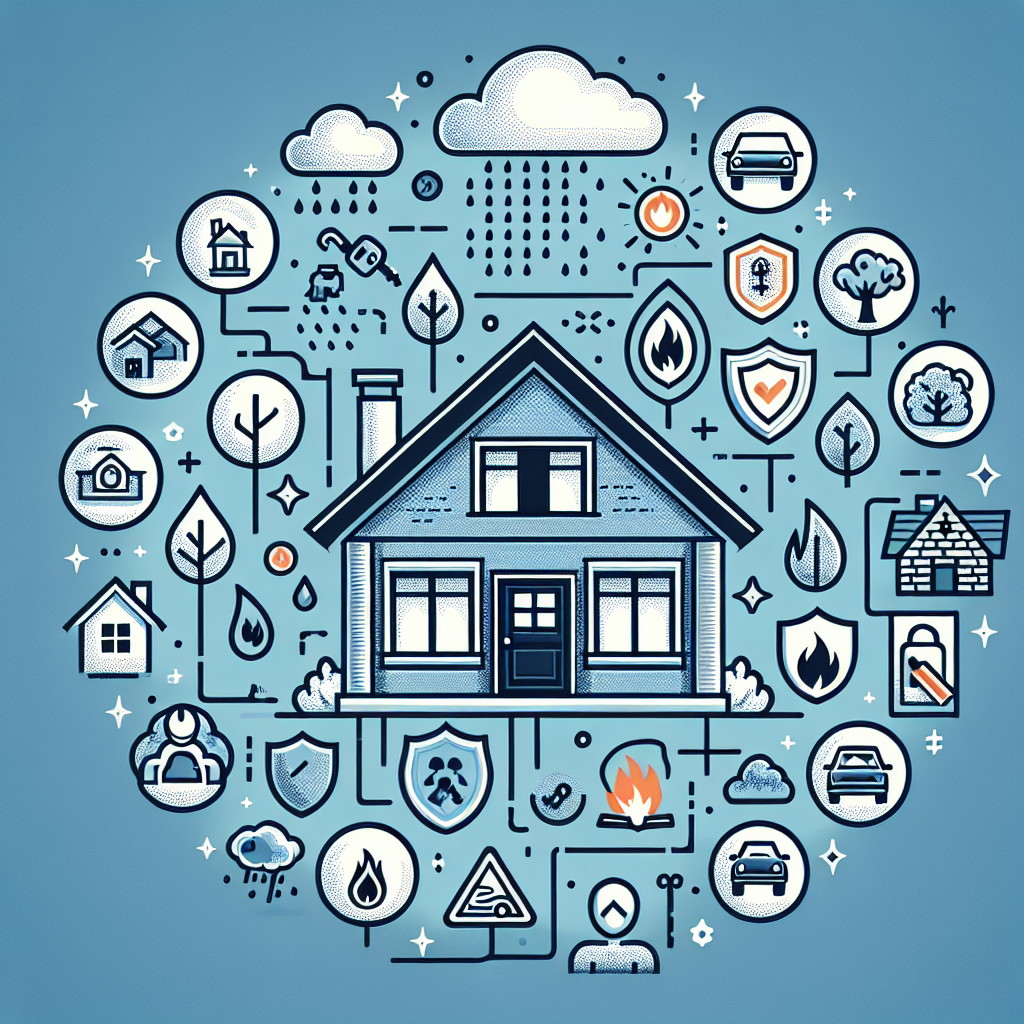Filed under Home Insurance on
Desjardins Home Insurance Coverage: A Complete Guide

Your home is more than an address; it’s a financial foundation and a place where your life happens. In a landscape of rising construction costs and weather-related losses across Canada, having the right protection is essential. If you’re considering Desjardins for your policy, this complete guide explains what’s included, what to add, how pricing works, and how to tailor Desjardins Home Insurance Coverage to your needs.
What a Standard Home Policy Typically Covers
At its core, Desjardins Home Insurance Coverage is designed to help you rebuild, replace, and recover after a covered loss. While policy specifics vary by province and product form, the following pillars usually apply to houses, condos, and rental units (with differences for each property type).
Dwelling and Other Structures
Dwelling coverage protects the structure of your home—walls, roof, floors, built-in fixtures—against insured perils like fire, windstorm, theft, and some types of water damage. It usually extends to detached structures on your property, such as a garage, shed, or fence, often as a percentage of your main dwelling limit.
Key point: Your limit should reflect the estimated rebuild cost, not the home’s market value. Construction labour, materials, demolition, debris removal, and architectural fees influence this number. If you’ve renovated your kitchen or finished a basement, update your insurer so your limit keeps pace.
Personal Property
This coverage reimburses the contents of your home—furniture, clothing, electronics, cookware, and more—if they’re lost or damaged by a covered peril. Two valuation methods are common:
- Replacement cost: Pays to replace items with new ones of similar kind and quality, without depreciation.
- Actual cash value: Replacement cost minus depreciation. Premiums are lower, but payouts can be significantly reduced.
Some categories have sub-limits (for example, jewelry, art, bicycles, collectibles, or certain electronics), so consider scheduling high-value items to fully protect them.
Additional Living Expenses
If a covered loss makes your home uninhabitable, additional living expenses (ALE) help pay for temporary housing, meals, and extra transportation. Keep your receipts; adjusters typically reimburse reasonable, necessary costs above your normal spending.
Personal Liability and Medical Payments
Liability coverage protects you if you’re found legally responsible for bodily injury or property damage to others—think a guest slips on your icy steps or your tree falls on a neighbour’s garage. Coverage can also travel with you away from home. Medical payments to others, which are smaller no-fault benefits, may cover minor injuries regardless of liability.
Condo, Tenant, and Landlord Variations
- Condo owners: You’ll want unit improvements coverage, loss assessment protection, and a policy that complements your condo corporation’s master policy.
- Tenants: A renter’s policy covers your belongings and liability; it’s affordable and often required by landlords.
- Landlords: If you rent out a property, consider a policy that covers the building, landlord liability, and loss of rental income after an insured loss.
Optional Endorsements Worth Considering
Endorsements allow you to customize your Desjardins Home Insurance Coverage beyond the base policy. The right add-ons can be the difference between a partial payout and being truly made whole.
Water Damage: Layer Your Protection
- Sewer backup: Covers backups or overflows from sewers, drains, and sump pumps—a leading cause of home claims.
- Overland water: Helps when water enters from above ground due to heavy rain or melting snow. Availability varies by location and flood risk.
- Groundwater: Addresses seepage and sudden water entry from the ground in some products.
With climate change driving more intense storms, water endorsements have moved from “nice to have” to essential in many Canadian regions.
Earthquake Coverage
In higher-risk zones—parts of British Columbia and the St. Lawrence Valley—earthquake coverage can be critical. Expect a separate, higher deductible for quake losses, often expressed as a percentage of the dwelling limit.
Service Line Coverage
Service line protection addresses the cost to repair or replace underground utility lines on your property—water, sewer, power—that you’re responsible for. Repairs can be surprisingly expensive; this add-on helps fill a common gap.
Equipment Breakdown
Equipment breakdown coverage can help with sudden mechanical or electrical failures of major household systems, like HVAC, heat pumps, and built-in appliances, when those failures aren’t due to wear-and-tear alone. It’s a modern safeguard in an increasingly electrified home.
Scheduled Personal Property
High-value items—jewelry, watches, art, instruments, bicycles, sports gear, camera equipment—often need to be listed or “scheduled” with appraisals for full protection and no deductible. Scheduling ensures you’re not capped by standard sub-limits.
Identity Theft and Cyber
Identity fraud can create weeks of administrative headaches. An identity theft endorsement can cover certain restoration expenses and provide support. Some packages also include emerging cyber protections for smart-home risks or online fraud.
Short-Term Rental
If you host paying guests—even occasionally—tell your insurer. Short-term rentals without proper endorsement can jeopardize claims. With the right add-on, you can protect your property and liability while hosting.
By-Law or Ordinance, Guaranteed or Extended Replacement
When rebuilding after a loss, you may need to upgrade to meet current building codes. By-law or ordinance coverage helps cover the added expense. Some policies offer guaranteed or extended replacement cost for the dwelling, adding a buffer if construction prices surge after a catastrophe.
What Desjardins Brings to the Table
Beyond standard protections, Desjardins is known for a cooperative, member-first model and a suite of tools that help prevent losses in the first place. These program features can enhance your Desjardins Home Insurance Coverage experience.
Cooperative Roots and Member Focus
Desjardins is part of a large Canadian cooperative financial group. Many homeowners value this structure because it emphasizes member needs, community investment, and long-term stability over short-term gains.
Smart-Home and Weather Tools
- Water leak prevention: Eligible customers may access smart water sensors through program partnerships that can detect leaks early and may qualify for a discount.
- Severe weather alerts: Tools that warn you about hail, heavy rain, or wind give you time to secure property, close windows, or move vehicles.
Preventive tech can reduce loss frequency, support safer homes, and, over time, contribute to more stable premiums.
Claims Support and Preferred Contractors
Insurers maintain vendor networks to speed up emergency services and repairs after a loss. A vetted contractor network helps ensure workmanship standards and warranty support. If you prefer your own contractor, discuss it with the adjuster to align on scope and pricing.
Bundling and Group Programs
Bundling home and auto policies with the same insurer typically earns a discount. As a large financial group, Desjardins also supports various affinity and group programs that can reduce premiums for eligible members.
How Much Coverage Do You Need?
Customizing Desjardins Home Insurance Coverage starts with selecting the right limits and deductibles. A little homework up front saves headaches later.
Calculate Rebuild Cost, Not Market Value
- Measure and describe: Square footage, number of stories, architectural style.
- Material and finish quality: Roofing type, flooring, cabinetry, countertops, fixtures.
- Unique features: Custom millwork, fireplace, finished basement, energy-efficient systems.
- Local costs: Labour rates, debris removal, permits, and design fees in your area.
Use a rebuild cost estimator and update after renovations. Underinsuring might save a few dollars in premium but can devastate a claim payout.
Align Personal Property with Your Lifestyle
Do a quick home inventory. Walk room to room, record a video, and list high-value items. Aim for a personal property limit that reflects total replacement. Review special sub-limits and schedule valuables to avoid surprises.
Set a Strong Liability Limit
Consider today’s litigation environment and medical costs. Many homeowners select at least $1–2 million in liability coverage. If you have a pool, trampoline, short-term rental, or frequent guests, consider higher limits or an umbrella policy.
Choose Deductibles Strategically
Higher deductibles lower premiums but require more out-of-pocket for small losses. Pick a level that won’t strain your emergency fund. Some policies offer separate (or percentage) deductibles for earthquake or wind/hail.
Keep Pace with Inflation
Inflation guard provisions help increase limits annually, but confirm your policy includes them. Construction inflation has been volatile in recent years; a quick check at renewal is worth it.
Common Exclusions and Limitations
No policy covers everything. Knowing the gaps helps you plan around them.
- Gradual damage: Wear-and-tear, deterioration, rot, or rust.
- Mold and vermin: Often excluded or heavily limited unless resulting from a covered event.
- Flooding: Overland flood usually requires an endorsement; storm surge and coastal flooding may be restricted.
- Earth movement: Earthquake or landslide typically excluded without an endorsement.
- Power failure and utility outages: Limited unless a covered peril triggers the loss.
- Illegal or intentional acts: Not insurable.
- Vacancy: Extended vacancy can nullify certain coverages; advise your insurer if your home will be vacant.
- Business use: Running a business at home can change risk; you may need a rider or commercial policy.
What Drives Your Premium
Pricing reflects your property’s risk profile and coverage selections. These factors commonly influence the cost of Desjardins Home Insurance Coverage:
- Location: Crime rates, proximity to hydrants or fire halls, and local weather patterns.
- Construction features: Roof age and material, wiring type (e.g., aluminum, knob-and-tube), plumbing (galvanized vs. PEX), heating system, and oil tanks.
- Home age and updates: Newer roofs, upgraded electrical panels, and modern plumbing help.
- Claims history: Prior losses at your address or personal claim history can affect rates.
- Coverage and deductibles: Higher limits and optional endorsements raise premiums; higher deductibles lower them.
- Occupancy and use: Short-term rentals, home businesses, pools, and wood stoves can add risk.
- Credit-based insurance score: With your consent and where permitted by law, some insurers consider it as one of many rating factors.
- Loss mitigation: Sump pumps with battery backups, backwater valves, monitored alarms, and water-leak sensors often earn discounts.
Ways to Save Without Sacrificing Protection
Smart savings keep your wallet and your coverage healthy. Desjardins typically supports a variety of discount opportunities and risk-based savings strategies.
- Bundle home and auto with the same insurer for a multi-policy discount.
- Install a monitored burglary and fire alarm.
- Add a backwater valve, maintain your sump pump, and place smart leak sensors near appliances.
- Stay claims-free and opt for a sensible deductible.
- Update roofing, wiring, and plumbing; document the upgrades.
- Ask about loyalty, group, or mortgage-free discounts if applicable.
- Limit small nuisance claims; paying minor losses out of pocket may protect future insurability and discounts.
How the Claims Process Typically Works
A smooth claim starts before a loss—with documentation and preparedness—and continues with clear communication.
Immediate Steps After a Loss
- Ensure safety: Evacuate if needed; call emergency services.
- Prevent further damage: Shut off water, board up broken windows, or tarp the roof when safe.
- Document: Take photos and videos before cleanup.
- Notify the insurer promptly: Report what happened and the extent of damage.
During the Adjustment
- Adjuster contact: An adjuster will review coverage, request information, and possibly inspect the property.
- Estimates: You may receive contractor estimates; discuss scope and materials to align on quality and cost.
- Receipts and inventories: Provide lists and proof of value for contents. Your pre-loss inventory speeds things up.
- ALE tracking: Keep a simple log for temporary living expenses to support reimbursement.
Settlement and Repairs
Payments may be issued in stages—for example, an initial actual cash value payout followed by replacement cost holdback once repairs or replacements are completed. Ask about timelines, dispute options, and warranties on work done by preferred vendors.
Risk-Reduction Checklist for Homeowners
Reducing risk helps protect your family and can stabilize insurance costs over time.
- Water: Install leak sensors, maintain caulking, test your sump pump annually, and consider a smart shut-off valve.
- Roof: Inspect shingles and flashing; clean gutters spring and fall.
- Electrical: Replace outdated wiring and panels; avoid overloading outlets.
- Heating: Service furnaces and chimneys annually; keep combustibles clear.
- Security: Exterior lighting, quality deadbolts, and a monitored alarm deter theft.
- Yard: Trim trees away from roofs; store patio furniture before windstorms.
- Documentation: Keep digital copies of receipts and a home inventory in the cloud.
Provincial Nuances and Eligibility
Insurance rules, product options, and rating factors can vary by province. Overland water may be unavailable in high-flood zones; earthquake deductibles and pricing will differ in B.C. and parts of Quebec; and the use of credit-based scoring differs by jurisdiction. French-language service is readily available in Quebec, with English service nationwide. Confirm availability and policy wording for your address when you quote.
Frequently Asked Questions
How is rebuild cost determined?
Insurers use data on square footage, construction type, local labour and material costs, and features like custom finishes or complex roofs. Share renovation details and updated measurements to improve accuracy.
Do I need overland water coverage?
If you live near rivers, in a low-lying area, or in a city prone to heavy rainfall, overland coverage is highly advisable. Many of Canada’s costliest home claims in recent years involve water.
What if I work from home?
Occasional remote work typically doesn’t change your risk profile. However, if clients visit the home or you store inventory or specialized equipment, ask about a home business endorsement or a separate commercial policy.
Are high-value items fully covered?
Not by default. Standard sub-limits apply to jewelry, art, bikes, and more. Scheduling items with appraisals ensures full protection and may remove the deductible for those items.
Will my premium go up after a claim?
It can. The impact depends on claim type, severity, and your history. Some policies offer claim forgiveness options for your first eligible claim—ask if this is available and how it applies.
Does my policy cover short-term rentals?
Not automatically. Hosting paying guests requires disclosure and often an endorsement. Without it, claims related to hosting may be denied.
What happens if construction costs spike during repairs?
Inflation guard and extended or guaranteed replacement features help buffer cost spikes. If those are not included, discuss adding them at renewal so you’re better protected next time.
Is Desjardins Right for You?
The best insurer combines solid coverage, helpful service, and risk-prevention tools. If you value a cooperative financial group, smart-home prevention programs, and the ability to tailor protection with endorsements, Desjardins is worth a close look. Compare premiums, coverage features, and claims support with at least two other quotes to ensure fit and value.
Action Plan: Build a Smarter Policy
- Inventory your home and list valuables to schedule.
- Review your rebuild cost and update after renovations.
- Layer water protection and consider service line, equipment breakdown, and by-law coverage.
- Set liability at $1–2 million or higher based on your risk.
- Choose a deductible that matches your emergency fund.
- Ask about discounts for bundling, sensors, and security upgrades.
- Revisit your policy annually as your life and home change.
With the right mix of limits, endorsements, and preventive tools, Desjardins Home Insurance Coverage can do more than pay claims—it can help you avoid them. That’s the real value of a modern home policy.
Final word: The shape of risk is changing, from extreme weather to a glut of connected devices in our homes. A thoughtful approach to Desjardins Home Insurance Coverage, paired with practical upgrades and consistent maintenance, puts you in control. Get quotes, ask informed questions, and keep refining your protection so your home stays secure—no matter what comes next.




